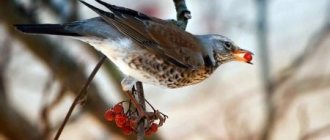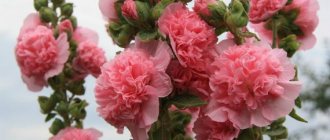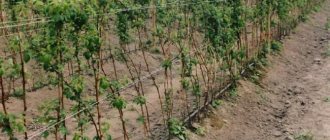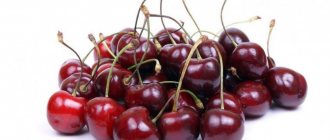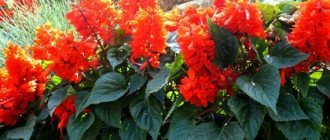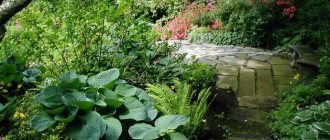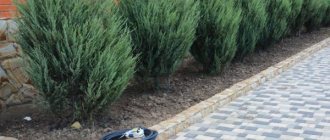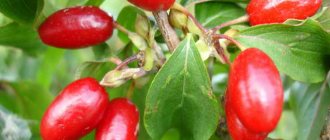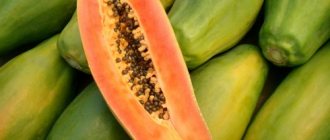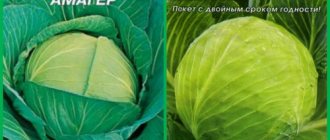The white dogwood plant (Cornus alba), which is also called white svida, or white svidina, or white telecrania, is a species of the genus Dogwood, which belongs to the Dogwood family. This plant is also considered a very close relative of silky or scion. Under natural conditions, this plant can be found in China, Mongolia, Korea, and it also grows in an area stretching from Japan and the Far East to the European part of Russia. This plant prefers to grow in the undergrowth of dark coniferous swampy forests.
The name of the genus in Deren Bely means “horn”. In this genus, the most widespread is the white derain shrub, which is why it is often used in urban landscaping.
Brief description of cultivation
- Bloom . The shrub blooms luxuriantly from early to mid-summer. It blooms again in the first weeks of autumn.
- Landing . In autumn during leaf fall or in spring - before sap flow begins.
- Watering . While the plant is young, it is watered once or twice every 7 days. Adult bushes are watered only during prolonged drought, twice or thrice a month, and from 15 to 20 liters of water are taken per plant.
- Fertilizer . If the soil is nutritious, then the turf will be able to grow normally without fertilizing. In depleted soil in the spring, 100 to 150 grams of mineral complex fertilizer should be added to the soil under the bush. And in the summer months, 5 to 7 kilograms of humus are added under the bush.
- Trimming . After the white dogwood turns 3 years old, it begins to be trimmed regularly. They do this 2 times a year, or more precisely: in July and August. Species and varieties that have richly colored bark should be pruned at the very beginning of spring, but only once every few years.
- Reproduction . Layering, seed method and cuttings.
- Pests . Aphids and scale insects are comma-shaped.
- Disease . Powdery mildew.
Diseases and pests
A strong adult plant is resistant to most common diseases and ailments, but a young shrub cannot boast of such resistance. It can be affected by fungal diseases, most often powdery mildew. It appears as a whitish coating or drops of liquid on the leaves of the plant, usually in early spring. A weakened tree does not bloom , its leaves become pale and dry and fall off.
To prevent powdery mildew, the plant should be watered exclusively at the root, and the root system should be thinned out in the spring and autumn seasons. When signs of the disease appear, infected branches are pruned, and the remaining ones are treated with specialized preparations.
Among the pests that attack turf, the most dangerous include aphids and comma scale insects (damages foliage).
Whatever variety of turf is chosen for the garden plot - Viridissima, Sibirika, Aurea Elegantissima, Ivory Hal or Albo-marginata (sprouting turf) - it will certainly decorate any area, delighting its owners throughout the year. A big plus for purchasing it is also the ease of keeping it looking beautiful. Having bought an adult turf from a specialized nursery, you can forget about the efforts to germinate it from seeds.
Features of white wood
White dogwood is a highly branching shrub. Its bare and straight branches are quite flexible, and over the years they begin to arch. The branches can be colored red-black, red-coral or brown-red. The height of the bush can reach up to 300 cm. The entire oppositely arranged leaf plates have an elliptical shape, petioles and pubescence on the surface. Their width can vary from 10 to 70 mm, and their length - from 20 to 100 mm. On the surface of the plate, three to five arcuate veins are clearly visible. The front surface of the foliage is dark green, and the back surface is pale gray. The lush apical corymbose inflorescences reach 30–50 mm in diameter and contain small white flowers with only 4 petals. The bush blooms lushly in early to mid-summer. And in the first weeks of autumn, re-blooming is observed. The fruit is a berry-shaped drupe. Unripe fruits are pale blue, which changes to blue-white as they ripen. Ripe drupes become flattened. Fruiting and flowering of the white tree is possible only after it is 2 or 3 years old.
This plant is resistant to heat and cold, tolerates winter well, can grow in the shade, any soil is suitable for it, and it also feels great in city conditions. It is thanks to its unpretentiousness and spectacular appearance that this shrub has gained great popularity among gardeners.
White dogwood: features, planting and care - 7 cottages
Varieties and types of derain with photos
White dogwood (Cornus alba) , also called alba dogwood or variegated dogwood. Known in culture since the beginning of the 19th century and most popular in garden design due to the high decorativeness of its varietal forms.
Growing scarlet in the garden
The stems growing from the center are straight, and the side shoots can bend towards the ground. This spreading shrub with variegated leaves reaches about 3 m in height in nature and stands out for its purple-red, carmine-pink or purple-burgundy autumn foliage.
It blooms at the turn of May and June with numerous small creamy-yellow flowers collected in flat umbrella inflorescences. The bluish-white spherical fruits ripen in late summer and autumn.
One of the decorative features of the species and all its varietal forms is the intense color of the turf shoots in winter, as if painted with coral-scarlet paint. The smooth bark is covered with a waxy coating, giving the stems shine.
On shoots older than two years, the red color is no longer so bright, so pruning is necessary every 2-3 years. New spring growth is green in color and subsequently turns red later in the season. The plant is very resistant to low temperatures and is rarely affected by pests or diseases.
White turf varieties
Derain "Aurea" (Aurea). In addition to the colored shoots, the variety impresses with its golden-yellow spring and summer foliage.
Cornus alba variety "Aurea"
Derain "Sibirica" (Sibirica) is known for its bright red stems in winter, which are especially spectacular on sunny days against a backdrop of snow. The leaves are pale green with white edges. The variety was awarded by the British Royal Horticultural Society.
Winter color of the “Sibirika” variety
Sibirica Variegata Derain Beautiful variegated foliage in shades of cream and green covers the shrub in spring and summer, making it an interesting addition to garden design. In autumn it acquires all shades of pink, purple, bronze.
"Sibirica Variegata"
Similar-looking variegated varieties of white turf "Elegantissima" and turf "Ivory Halo" (Ivory Halo or Baihalo) with a white uneven rim along the edge of the light green leaf plate and dense red shoots.
From a distance the bushes look as if they are covered with flowers. In autumn the leaves turn purple-red. Plant height is about 2.5 meters.
"Elegantissima"
Derain "Spet" (Cornus alba Spaethii). A fast-growing shrub reaching 1.5 meters in height with straight, usually unbranched shoots.
The outstanding ornamental features of this variety are the bright red winter stems and leaves with a bright golden-yellow irregular border along the edges with a red-pink tinge at the end of the season. 'Spaethii' is very similar to the white turf variety 'Gouchaultii', with which it is often confused.
Variety "Shpeta"
Derain "Siberian Pearls" A delightful compact variety with long, abundant flowering. By fall, numerous clusters of bluish-white, pearl-like berries ripen, contrasting spectacularly against the purple-burgundy fall foliage and bright red stems.
"Siberian Pearls"
Another variety of this type of tree is “Kesselringii”. It is a multi-flowered shrub that forms thickets of dark red stems that turn purple-chocolate in winter and brown-red at the base. Green seasonal foliage turns purple and red as fall arrives.
"Kesselrings"
Blood red dogwood (Cornus sanguinea) or blood red dogwood. This is a medium-sized bush about 2 meters high. Garden varieties are often called "winter fire" because their leaves turn orange-yellow in the fall and then fall off to reveal colorful shoots.
"Anny's Winter Orange" is one of the best varieties of this species. In spring and summer, large, green leaves contrast with pale yellow-orange stems.
"Anny's Winter Orange"
In autumn, the bush is strewn with clusters of dark purple berries, the foliage acquires orange-gold and coral shades, and when it falls, it opens shoots that turn orange-scarlet with frost. The variety is a winner of the prestigious Garden Merit Award from the Royal Horticultural Society.
Buddleia varieties with photos
Sprouting dogwood or shiny dogwood (Cornus stolonifera syn. Cornus sericea) . In the wild it grows in areas with moist soil in wetlands. Height 1.5-4 meters. It spreads easily by underground lateral rhizomes, which produce new shoots. The branches are dark red in the sun and brownish-green when planted in the shade.
Yellow turf "Flaviramea" is a well-known variety of this species. It is a compact low bush, the decorative feature of which is bright yellow winter shoots.
"Flaviramea"
Canadian turf (Cornus cyananthus) is a miniature ground cover species with a height of only 20 cm. As it grows, it forms green carpets strewn with cream or white flowers in the spring and red, edible berries in the fall.
For successful cultivation it requires partial shade and moderately moist soil with a slightly acidic reaction. This is a frost-resistant species that can withstand temperatures down to -40 ° C, and is resistant to pests and diseases.
Cornus cyananthus
Deren Kousa (C. Kousa) or Chinese. The species belongs to the group of beautifully flowering dogwoods. Its peak flowering occurs in June and amazes with its splendor. The tree is strewn with large flowers of pink, white or red-pink color, depending on the variety. After flowering, delicious red fruits are produced.
"Miss Satomi"
Pink flowering varieties: “Miss Satomi”, “Scarlet Fire”. White and creamy-white flowers: “China girl”, “Milky way”, “Venus”, variegated varieties with different flower colors “Akatsuki”, “Summer Fun”, “Wolf's Eyes”.
Planting white dogwood in open ground
What time to plant
White tree seedlings are planted in open ground at the beginning of spring, and this must be done before sap flow begins. This procedure can also be carried out in the fall during leaf fall. Most gardeners prefer to plant such shrubs in the autumn, because in early spring, fully established and rooted seedlings immediately begin to actively grow. When planting a seedling in open ground in the spring, experts advise trying to take the roots along with a large lump of earth while transferring it into the hole (the larger the lump, the better). Thanks to this, you will be able to protect the plant from stress that may occur after transplantation.
Since white derain is a shade-tolerant plant, it is often planted in shady areas or even in the shade, for example: along blank fences and walls or under large trees. But it should be remembered that varieties and varieties with variegated foliage need a lot of light, otherwise their leaves may lose their decorative effect.
Landing rules
White dogwood is distinguished by the fact that almost all types of soil are suitable for it. It grows well on rocky soil, light sandstone, and heavy loamy soil. But it should be noted that the soil must be neutral.
It is best to use seedlings for planting that are no more than four years old, as they take root faster, and if they are pruned, they will grow a large number of young shoots. Before planting a seedling, its root system is immersed in water, where it will remain for several hours. During this time, the roots will have time to absorb a sufficient amount of moisture, thanks to which they will better tolerate the transplant. If a seedling with a closed root system is used for planting, then there is no need to pre-soak it.
The size of the hole should be ¼ part larger than the volume of the root system taken together with the lump of earth. If the soil in the area is swampy, then white turf will be able to grow normally on it only if you provide it with good drainage. To do this, at the bottom of the planting hole, you should make a drainage layer of sand, which is combined with crushed stone or pieces of brick. The thickness of such a layer should reach about 15 centimeters. Please note that if the groundwater in the area lies quite deep or the soil in the area is dry, then there is no drainage at all in the planting hole or the bottom is covered only with a layer of sand.
After the seedling is placed in the planting hole, it should be covered with a soil mixture consisting of humus, compost and the top layer of soil (remaining after preparing the hole). When the bush is planted, compact the surface of the soil in the circle around the trunk and water it with plenty of water. Once the liquid has been absorbed, cover the surface of the soil around the bush with a layer of mulch (organic material). Make sure that the root collar after planting is level with the surface of the area.
Doren. Planting, care and pleasure.
Landing Features
In planting and care, white turf is rightfully considered one of the most unpretentious and, of course, beautiful plants. Planting a shrub in open ground and then caring for it is not difficult and will be feasible even for novice gardeners who do not have special skills.
The best place for it will be an open or semi-shaded area with saturated, moist soil rich in humus.
At the same time, it is very important that the water in the ground does not stagnate and the roots of the plant do not rot, for which it is necessary to take care of good drainage at the site of future planting. Recommendations before boarding:
- Before planting directly, the shrub is immersed in water for 2 hours.
- It is recommended to add humus and compost to the pit.
- The surface layer of the earth must be mulched so that the freshly planted turf does not suffer from weeds and retains a sufficient amount of moisture in its roots during the dry period.
Caring for the plant is not difficult, but you should not neglect mulching and using organic materials for it. Also, do not forget to water the turf on time and sufficiently during the hot, low-rainy season, loosen the soil around the bush and get rid of weeds.
It is important not to ignore branch pruning. There are special rules for this. If you want to see variegated shoots in winter, then you need to prune the plant in early spring, getting rid of branches almost to the very root. Over the spring and summer, the turf will grow fresh, bright shoots and by fall it will look great. This contributes to greater bushiness, but reduces the number of inflorescences of the plant, and, consequently, berries.
If preference is given to the growth of the shrub in height, as well as its abundant flowering, it is better to trim the turf in the autumn . The branches are cut to the desired length. This option allows you to grow a tall, neat, harmonious plant, suitable for the role of a hedge or as part of a complex composition.
White dogwood care
Despite the fact that white dogwood is distinguished by its unpretentiousness, it still needs to be well looked after. It should be cared for in almost the same way as other garden crops.
Watering
Particular attention should be paid to watering young, immature bushes. They are watered regularly 1 or 2 times every 7 days. Older shrubs need watering only during periods of prolonged drought. So, in the summer during a drought, it will be enough to pour one and a half to two buckets of water under each bush 2 or 3 times a month. When the bush is watered, loosen the surface of the soil in the circle around the trunk and pull out all the weeds.
Fertilizer
White turf does not need fertilizing, especially if the soil on the site is saturated with nutrients. However, if you want the bush to be powerful and bloom profusely, then in the spring you should add from 100 to 150 grams of the mineral complex to the soil around the trunk, and in the summer - from 5 to 7 kilograms of humus or compost.
Trimming
After the bush is 3 years old, systematic formative pruning begins. If this rule is neglected, then the white tree will soon begin to gradually expose the lower part of the bush. To ensure that the shrub is always compact and attractive, every third or fourth stem should be completely cut off. All weakened, injured and diseased branches are also cut out, leaving only the strongest and most developed. If white turf is used to create a hedge, then its first cutting should be done in July, and again in August (when the stems grow back).
If you grow varieties whose bark is brightly colored, then they are trimmed only once over several years, and this procedure is carried out in early spring, before the buds open. In this case, the bush should be shortened to 20 centimeters from the soil surface, which will allow it to rejuvenate: it will begin to actively grow a large number of young branches.
You can form the crown of the derain in various ways. The most popular options are: arc, cube, column, hemisphere and ball. The crown of such a shrub can also be formed in the form of a standard tree (1 trunk). Some varieties and varieties of this plant do not require formative pruning, since the shape of their crown is already quite attractive. However, all the same, such bushes are regularly subjected to sanitary pruning.
How to trim turf
Diseases and pests
An adult, powerful white dogwood bush is highly resistant to diseases and pests. But while the shrub is young, it is often affected by powdery mildew, and pests such as aphids and scale insects can also settle on it.
In spring, a plant affected by powdery mildew develops a whitish coating on the surface of the foliage. As soon as possible, cut off all diseased branches and treat the plant with a solution of Fundazol or Bordeaux mixture (1%). And to get rid of pests, spray the bush with an acaricide solution, for example: Actellica, Bankola, Aktary, Akarina or Biotlina.
Decorative turf - care after planting
Dera seedlings after planting are very sensitive to drought, so watering is carried out in the absence of rain once every 2 days for a month, and then over the next year they are watered abundantly once every 1 week, maintaining average soil moisture. In the summer heat, watering is increased.
Variegated turf in autumn, variety “Wolf's Eyes”
Mature 4-5 year old plantings can withstand short-term drought, but in conditions of prolonged absence of water the foliage withers and dries out. After abundant irrigation (2-4 buckets per bush), the elasticity of the leaves is restored. Irrigation in summer is best done in the evening, pouring water into the hole near the trunk.
Attention! Good growth and decorativeness of the crop are possible only with constant substrate moisture
Mulching the soil around plantings, especially young ones, will help prevent the evaporation of water from the soil and protect it from overheating in summer and cold in winter. Mulch from compost or peat is poured in a circle near the trunk, without touching the base of the shoots or the trunk.
Some varieties can freeze in cold winters, but Kousa turf is especially sensitive to cold. Young plants of this species need shelter made of non-woven material, and the roots are protected from a high layer of mulch from spruce branches or fallen leaves.
Caring for derain in the garden includes seasonal fertilizing. For good growth and flowering, feed with balanced slow-acting mineral fertilizers in the form of powder or granules.
Fertilize during the active growing season of shoots in May-June. In autumn, potassium fertilizing is relevant, increasing the plant’s resistance to low winter temperatures and diseases.
Reproduction of white dera
White dogwood can be propagated by generative (seed) and vegetative (cuttings and layering) methods.
Growing from seeds
The seed material of this plant has a very high germination rate (about one hundred percent). Sowing of seeds is carried out in the autumn immediately after they are collected. Since the seeds remain viable for about 5 years, sowing can be postponed until spring, but in this case they will need stratification: in winter they are kept at a temperature of 5 degrees for at least eight weeks. When sowing, remember that per 1 square meter of land there should be no more than 5–15 seeds, which are buried 40–50 mm into the soil. You will not see seedlings soon; they often appear only in the second or third year after sowing. And only after 5–8 years, a bush grown from seeds will have a standard size for a given plant. That is why most gardeners prefer to use vegetative methods for propagation.
Propagation by cuttings
From a powerful and healthy plant in the first days of June, it is necessary to cut off slightly woody stems, and each cutting should have from 7 to 9 buds. Plant the cuttings for rooting in a container filled with a suitable soil mixture. It is best for cuttings to take root in a greenhouse. During rooting, do not forget to water the cuttings in a timely manner, as well as feed them with mineral fertilizers and organic matter. By the first weeks of autumn, the cuttings should have taken root well and can be planted in the garden.
RULES FOR CUTTINGS OF DUREN
Reproduction by layering
The easiest way to propagate white turf is by layering. To do this, in the autumn, select a stem on the bush that grows very low from the ground surface. Dig a small groove and fix the stem in it, leaving only the upper part outside. Fill the ditch with fertile soil. Throughout the summer, the cuttings are regularly watered and fed. In late autumn, it is recommended to cover the cuttings with a layer of spruce branches or fallen leaves. With the onset of spring or the next autumn, separate the cuttings and plant them in a new permanent place.
Types of propagation of white turf
White turf reproduces in several ways. Each of them has its own characteristics and rules that must be followed.
Cuttings
Every year there is an opportunity to take young shoots from the plant. However, not every branch will become suitable for further planting. When choosing a shoot for planting, pay attention to branches with 7-8 healthy large buds. A key aspect is also the time of year to carry out this procedure. It is best to propagate derain from cuttings in autumn or spring. After separating the planting material, it is recommended to cover all sections with highly diluted succinic acid - this manipulation will improve their condition and help further favorable growth.
Before planting, each cutting is dipped into a container with nutrient liquid and only then sent to the greenhouse.
All summer, the cuttings should be kept in the greenhouse under your supervision. Leaves should appear from all the buds. In the warm season, planting material should be systematically watered, and various feeding complexes should be used. In autumn, the cuttings turn into full-fledged seedlings.
They should be planted in spring in pre-dug holes. The distance between seedlings should not be less than 25 cm. The holes must first be filled with natural fertilizers and special mixtures that promote the rapid fixation of cuttings in the soil and the appearance of new roots and shoots. If the branches were cut correctly, the plant will very soon delight you with lush shoots.
Layerings
The bush is distinguished by a spreading, voluminous crown, and its branches spread well along the ground, and therefore propagation of the tree by layering is possible.
Layers should be formed in the spring. To do this, it is better to choose a long, fresh branch. The shoot must be bent to the soil and buried, and in order for it to hold, it must be secured with staples.
Where the branch is buried, the ground should be mulched to concentrate nutrients and nutrients in it. Throughout the summer, the shoot should be watered and occasionally fertilized.
Next year, in spring or autumn, the fixed place should be periodically checked for the appearance of roots. If they appear, then the branch is separated from the main bush, and then transplanted. This is a very easy method, however, gardeners do not always trust it.
Seeds
Flowering of the tree begins in early summer. Gradually, instead of buds, purple or white seeds appear in the shape of balls. The grains ripen quickly during hot summer days, however, they can only be collected in the fall.
If the plant has been properly cared for over the summer, its seeds will be of high quality and will give rise to new bushes.
After collecting and drying the grains, they can be planted in the soil. It is better to do this in October, when the air is no longer too warm, and the ground sometimes freezes at night. Thanks to these conditions, the planting material will quickly adapt and begin to germinate well in the spring. You can sow grains in the spring, but it is better to keep them for some time at a temperature just above zero before doing so.
Varieties of white turf
White dogwood has a large number of different varieties and several decorative garden forms. The following garden forms are distinguished:
- Argenteomarginata . The bark of this shrub is red, and its green foliage has a whitish-cream edge. In autumn, the leaves turn a carmine-red hue. The variety of this form that is most valued by gardeners is Elegantissima: the stems of the three-meter bushes are red, the foliage has an uneven whitish-cream edging, as well as cream stripes and spots.
- Siberia . This low-growing shrub has stems that are colored a deep red. The greenish foliage changes its color to brownish-red in autumn. Popular varieties:
- Sibirika Variegata - a two-meter shrub has foliage decorated with a wide border of a creamy shade, as well as cream streaks and spots; in autumn it acquires a purple hue, the variety is similar to Elegantissima, but it grows more slowly, which allows it to decorate small gardens;
- Aurea - a two-meter bush with pale red stems, light yellow foliage, whitish-cream inflorescences and blue-white fruits.
- Kern . There are yellow spots on the surface of the green foliage.
- Shpeta . This form was born about 100 years ago. The height of the bush is about 200 cm, its stems are reddish-brown, and the green foliage is decorated with an uneven edging of a yellow-golden hue. In autumn, the foliage turns purple.
- Kesselrings. The stems are colored black-purple or reddish-black.
The following varieties are popular:
- Astrosanguinea . The one and a half meter bush has raspberry stems and green foliage.
- Allemans Compact . While the stems are young, they are colored red. The color of the leaves is rich green.
- Aurea Elegantissima . The two-meter shrub is decorated with yellow-feathery foliage.
- Blood Good . The height of the bush varies from 200 to 300 cm. The color of the foliage and stems is coral-red.
- Gouchaulti (Guhalti, or Gusholti) . On blood-red stems grow slightly drooping green leaf blades with spots of pink, white or red.
- Ivory Haylow . The spherical crown consists of red-hued stems and green leaf plates, decorated with a creamy-white wide border.
- Sibirika Ruby . The stems of the one and a half meter bush are red-coral. Dark green, rounded foliage that turns purple-red in autumn.
Low maintenance plants. Derain - overview of species and varieties.
Derain description
Depending on the species, representatives of the genus differ in size. Some of them are miniature, ground cover bushes only 20-30 cm tall, others are low shrubs and trees about 1-3 meters. But there are also very tall trees, reaching 7-9 meters in height.
Leaves with pronounced veins along the edge of the leaf, green or variegated. In autumn they turn yellow-lemon, pink or violet-purple.
Autumn foliage color
The hallmark of most decorative forms of derena are their colorful, glossy shoots, which, after the leaves have fallen, contrast effectively against the background of the autumn, winter and early spring landscape.
The size of the flowers varies depending on the variety, and the color ranges from white to pink or red-pink. Flowering of the tree lasts about two to four weeks. The red or whitish fruits are drupes with one or two seeds and juicy pulp.
White dogwood in landscape design
White dogwood is often used to create hedges, as it is very flexible and tolerates cutting well. Beautifully flowering and variegated forms and varieties look very attractive alone and in groups.
This plant is also often used to strengthen the banks of an artificial reservoir, since it does not suffer from stagnation of liquid in the soil, and looks good next to hostas and other coastal perennials. This shrub is also often planted in areas with multi-level complex terrain. Also, such a plant is often planted in the shade of large trees.
White derain also looks advantageous against the backdrop of evergreens, as it has spectacular foliage and stems. This crop retains its attractiveness throughout the entire growing season, which is its main advantage.
Description
The main varieties of shrubs are chimeras, since at the genetic level they are a mixture of several plants, due to which the variegated turf has such an unusual appearance. The plant has the following characteristics:
- smooth stems that change color from brown to brown-red or coral with the onset of cold weather;
- the height and width of a tall plant are 3 meters, low-growing specimens reach only 1.5 m;
- the leaves are large, ovoid, regardless of color, they always have white or yellow veins or edging;
- in spring the shrub blooms with small cream-colored inflorescences;
- In autumn, fruits appear that are inedible for humans.
Photos of the variegated tree show its high decorative value, due to which it is used for landscaping park areas and personal plots. The shrub is unpretentious in care and feels great in polluted places, so it is suitable for growing within the city.
We carry out pruning correctly
As mentioned above, when working with wood, you need to use good tools - sharp, well assembled. Then the cut sites heal quickly, infection does not get there and juice loss is reduced to a minimum.
The optimal time for work is the evening or morning of a cloudy day. In hot weather, pruning should not be done - moisture loss will increase. But before the rain is also not the best time - the streams can wash away dust from the leaves, and with them the infection, which will get into fresh wounds.
It is quite difficult to give specific advice on pruning, especially. After all, a lot here depends on the aesthetic preferences of the gardener. You just need to give the bushes the shape you want and make sure that the plant does not “blur”.
With rejuvenating pruning, everything is simpler - you need to remove old branches with faded bark to restore attractiveness and youth. They are removed at the root.
Sanitary pruning will also not cause trouble. Cut off damaged branches entirely or 5-10 centimeters below the problem area.
